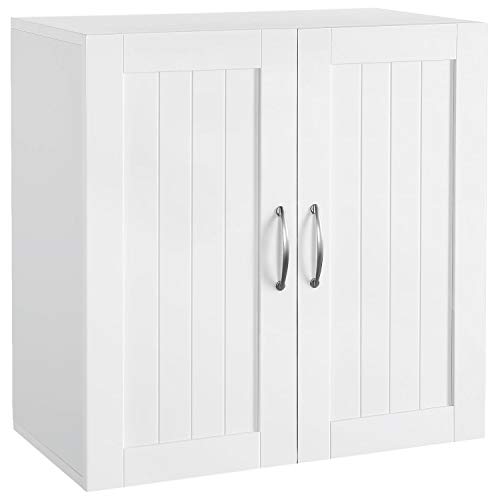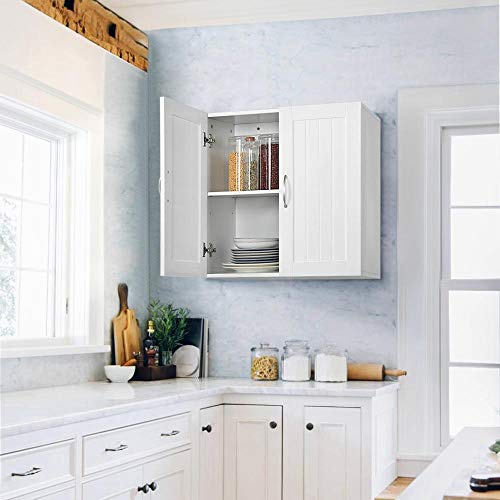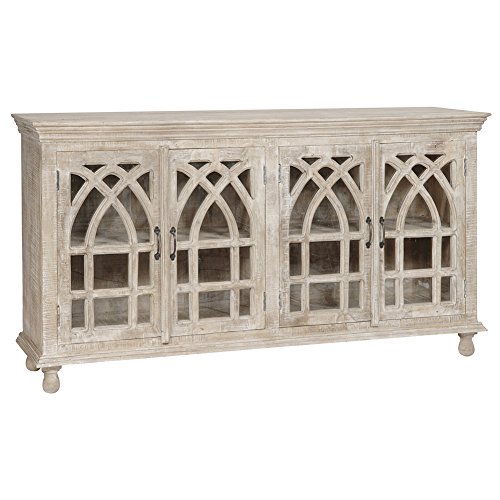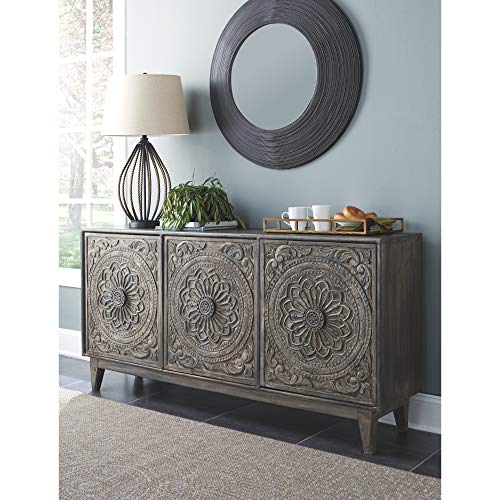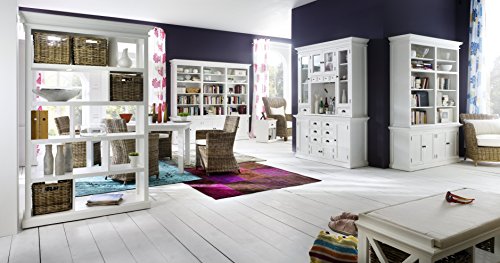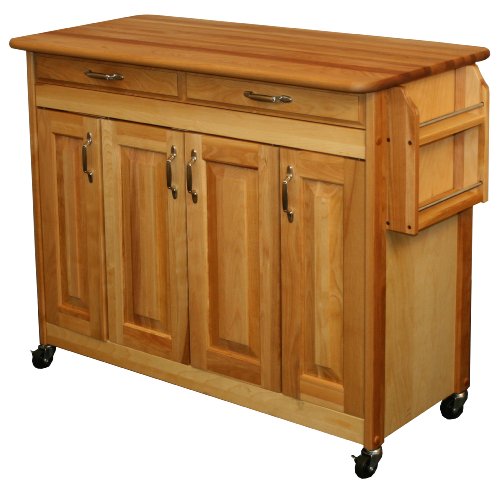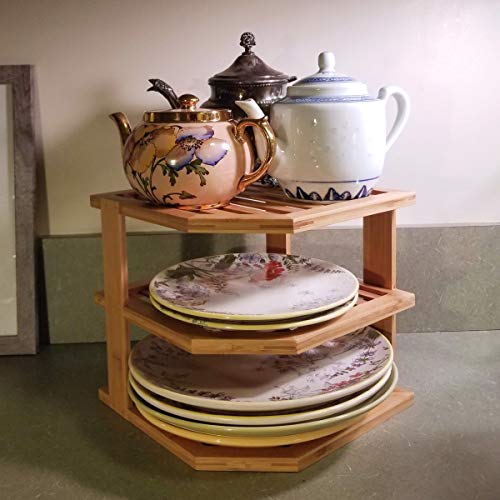Most Popular Kitchen Cabinets Styles And Colors
When it comes to updating your home, kitchen renovations tend to be the most expensive. It's estimated that most homeowners can expect to spend anywhere between $13,000 and $37,000 to complete their kitchen remodel, which equates to $75 to $250 per square foot. If you're replacing your cabinets, you can expect to be on the higher side of the scale.
It's the cost consideration that makes your cabinet selection process so important. When choosing cabinets, you want to do so with the mindset that they'll be in place for the next twenty years. Keep that in mind when choosing the color, style, and durability.
Here's an evaluation of some of the most common cabinet styles, and the pros and cons of each.
- 54 width is ideal for placement over a standard washer & dryer
- 2 adjustable shelves
- Assembly required
- Dimensions: 54W x 24H x 12D
- Material Type: Wood
Prices pulled from the Amazon Product Advertising API on:
Product prices and availability are accurate as of the date/time indicated and are subject to change. Any price and availability information displayed on [relevant Amazon Site(s), as applicable] at the time of purchase will apply to the purchase of this product.
Kitchen Cabinet Styles
Cabinet style pertains largely to the appearance of the front panel. There are endless designs available, but these five are the most common.
Shaker Style
Shaker style furniture has been around for centuries. This furniture style dates back to the 18th century Shaker people, who were master craftsmen who prioritized simplicity and quality. Shaker style cabinets are recognizable by their recessed center panel surrounded by a balanced wooden frame.
Pros of Shaker Style Cabinets
The main benefit of installing Shaker-style cabinets is that they're virtually timeless. The simplicity and unadorned cuts are fad-proof. You can install these cabinets today and feel comfortable knowing that you won't be tired of them ten years later.
According to the experts at Maplevilles Cabinetry, “Shaker-style cabinets are versatile enough to accommodate a range of kitchen styles.” While the traditional Shaker movement was unadorned and simplistic, you can add a modern flair to these pieces without compromising their integrity. From jewel tones to white kitchens, this style works with all of the color trends. Changing out the hardware for something more modern is a quick and easy way to change the look of your installation.
Finally, these cabinets are low-maintenance and easy to clean. This makes them an ideal choice for what tends to be a high traffic area and fits with the busy modern lifestyle.
Cons of Shaker Cabinets
There are some who find Shaker cabinets too plain or boring for their liking. This can impact homeowners or potential buyers who like a more bold, modern look. All-in-all, the pros of using Shaker-style cabinets outweigh the cons.
- The bath cabinet can be assembled on the wall or above the closestool or just place on the floor
- This 2 tiers cabinet is suitable for bedroom, bathroom, kitchen, drugstore and so on
- Perfect storage solution for your home
- Simple design looks beautiful and can fit in any decoration
- The wall mount cabinet is made of P2 MDF
- The fine surface finish makes this wall cabinet easy to clean and maintain
Prices pulled from the Amazon Product Advertising API on:
Product prices and availability are accurate as of the date/time indicated and are subject to change. Any price and availability information displayed on [relevant Amazon Site(s), as applicable] at the time of purchase will apply to the purchase of this product.
Cathedral Cabinets
Cathedral style cabinets are a little more ornate and classic than some of the other styles. They have a recessed center panel with three solid frames and a dramatic arch frame at the top. The frames are often beveled, creating more dimension on the front panel.
Pros of Cathedral Cabinets
Cathedral style cabinets aren't all one and the same. There are a lot of variations that allow remodelers to choose a style that suits them. For example, the arch style is a subtler swoop that isn't as ornate as the classic cathedral. You can choose to have arches at both the top and bottom or change it up depending on if you're installing top or bottom cabinets.
Not only are arched or cathedral cabinets more affordable than some of the other options, but they also contribute well to a vintage look. If you have high ceilings, cathedral cabinets can enhance that vertical space.
Cons of Cathedral Cabinets
When you get down to it, cathedral cabinets are dated. They're an interior design trend of a bygone era and don't work well in modern kitchens. As mentioned before, it's important to consider what's going to look good in ten years as well as right now.
Another challenge with the cathedral style is that it can be a nightmare to clean. With the beveled edges and fine grooves, they're a catchall for food scraps and drips from your counters. You can expect to have to use a toothbrush to restore your cabinets to their like-new shine.
Contemporary or Slab Cabinets
Slab or contemporary cabinets have no design features on the front panel. They're sleek, flat, and simple, and as close to a flat piece of wood as you're going to get.
Pros of Contemporary Slab Cabinets
In addition to looking sleek and modern, slab cabinets are the easiest design to keep clean. The lack of grooves and embellishments means that drips and splashes wipe right off.
Slab style cabinets are also quintessential elements of modern kitchen designs. “Flat-panel modern kitchen cabinets (slab) that are made of veneer wood have become quite popular in the last few years,” say the experts at Cabinet City, “long a standard of European kitchens, it's a sleek design now finally finding a place in U.S homes.”
Cons of Contemporary Slab Cabinets
One of the main cons of slab cabinets is that it's hard to find them in solid wood, and determining quality can be a challenge. For some, hardwood is the gold standard of cabinetry, and slabs are typically made with a veneer.
While we can build a veneer to last, especially compared to the products of ten years ago, finding a reliable manufacturer is key.
Cabinets With A Glass Front
Glass-front cabinets replace the solid panel with glass. These cabinets can fit many different design styles, from Shaker to cathedral. They're often restricted to upper cabinetry or as corner accent pieces.
Pros of Glass Cabinets
Glass cabinets are ideal for small spaces, as the light refraction can make a tiny kitchen seem larger. They're also nice for displaying well-organized dishes and valuables.
Adding lighting within the cabinet creates a soft diffused look in the evenings, and can catch fine crystal for a functional interior design feature.
Glass-front cabinets are also versatile. They work in elegant, classic kitchens as well as rustic country style kitchens.
Cons of Glass Cabinets
When you use glass cabinets, you need to prioritize keeping the inside tidy. It's easy for these cabinets to get smudged and dirty looking. Glass cabinets are often more expensive due to the extra labor and care that they require.
- 12 Drawers and 8 Doors
- Pure White Color
- Semi Gloss Painted Finish
- Antique Brass Hardware
- Hand Finished Furniture
- Solid Mahogany
- Halifax Collection
Prices pulled from the Amazon Product Advertising API on:
Product prices and availability are accurate as of the date/time indicated and are subject to change. Any price and availability information displayed on [relevant Amazon Site(s), as applicable] at the time of purchase will apply to the purchase of this product.
Hardwood Cabinets
The materials used to build your cabinetry will have the most impact on the cost of your project. Again, there are pros and cons to each type of material.
Hardwood is one of the most common materials used when building kitchen cabinets due to its durability. Some common wood types used include cherry, hickory, maple, oak, and birch. While all of these materials promise well-made cabinets, they offer variations in color, grain, and unique wood patterns.
Pros of Hardwood Cabinets
Hardwood cabinets are stunning. With the unique swirls and knots of the natural wood, no two cabinets will look exactly alike. These cabinets are durable and easy to repair and update. You can refresh them over the years with some sanding and refinishing. These cabinets help you follow some of the great color trends— white kitchens, two-tone, gray, black, and natural wood.
Cons of Hardwood Cabinets
Cost is a significant barrier to accessing hardwood. It can be the driving force that takes you from spending under ten thousand dollars to over on cabinets alone.
There's also a lot of misconception about how hardwood cabinets are built. According to Bestonlinecabinets.com, “There are many solid wood kitchen cabinets that can keep your out-of-pocket low, such as cabinets with plywood backing and sides,” These can dramatically reduce your total construction costs without impacting the strength and integrity of your cabinets.”
As full hardwood cabinets are sensitive to moisture and temperature variations, opting for pure hardwood can contribute to warping over time.
- Made from Solid Hardwood
- Made in the USA
Prices pulled from the Amazon Product Advertising API on:
Product prices and availability are accurate as of the date/time indicated and are subject to change. Any price and availability information displayed on [relevant Amazon Site(s), as applicable] at the time of purchase will apply to the purchase of this product.
Bamboo Cabinets
Bamboo is a popular alternative to hardwood. Contrary to popular belief, bamboo is actually a type of grass. Here are some of the reasons why bamboo is growing in popularity, both for cabinetry and flooring.
Pros of Bamboo
As bamboo is a grass, it's a highly sustainable and renewable source of materials. Furthermore, it's incredibly hard and durable, often more so than blended wood products that are commonly used as a more affordable alternative to hardwood.
Bamboo has an aesthetically pleasing light color and grain that looks fantastic in a modern kitchen.
Cons of Bamboo
As bamboo cabinets are relatively new to the market, they are often harder to find. For the same reasons, they can be quite expensive.
Plywood Cabinets
Plywood is formed by stacking layers of mixed materials in various angles. Furniture-grade plywood is commonly used to build the sides and back of cabinets.
Pros of Plywood
Thanks to the way plywood is assembled, it's a strong material. It's actually stronger than hardwood in terms of durability. Whereas hardwood is susceptible to warping over time, plywood is moisture and temperature proof.
Plywood is also more affordable than hardwood, as mentioned above. This makes it a viable option for a budget-friendly kitchen renovation.
Cons of Plywood
Consistency is often a concern with plywood. In many cases, the edges don't quite meet where they should. It's also important to find a cabinet maker who uses the right thickness to ensure a reliable, durable product.
Medium Density Fibreboard (MDF)
A strong and durable material made from a mix of fibers, wax, and resin. This is the most common material used in IKEA cabinets and furniture.
Pros of MDF
MDF is strong and durable. Like plywood, it's resistant to heat and moisture. It's also a more affordable alternative to hardwood and plywood while being more durable than the cheapest option, particleboard.
Cons of MDF
MDF is not as strong as plywood or hardwood and can be susceptible to sagging if you put too much weight in your cabinets.
Stock Cabinets
The level of customization you choose will directly impact your budget. However, it's nice to have a few custom options to personalize your space and streamline the flow of your kitchen. Here are the pros and cons of buying stock cabinets versus adding customized elements.
Stock cabinets are already built and awaiting pick up. They offer a variety of shapes, sizes, colors, and materials so that you can click and pick what you want to be delivered.
Pros of Stock Cabinets
Stock cabinets are the most affordable option when it comes to buying new kitchen cabinets. Not only will this option help keep your costs low, but it can drastically reduce your kitchen remodel timeline. When you use stock cabinets, you can expect to have them delivered and installed within days.
Cons of Stock Cabinets
When you buy stock cabinets, your options will be greatly limited. Many homeowners complain that they can't find a combination of the style, colors, and materials they want to create their ideal kitchen.
Stock cabinets can also be challenging if you have an irregular kitchen shape or size. It can make the installation process difficult and cumbersome, and often bring forth some unplanned cost considerations.
Semi-Custom Cabinets
Semi-custom cabinets are the middle ground between custom and stock cabinets. Think stock cabinets with customizable upgrades.
Pros of Semi-Custom Cabinets
When you order semi-custom cabinets, you get the same benefits as stock cabinets. Additionally, you have more flexibility in designing your kitchen. An example of a semi-customized cabinet would be choosing to install a lazy Susan in a stock corner cabinet.
Cons of Semi-Custom Cabinets
You can expect to pay slightly more for semi-custom cabinets. It's also possible that you'll experience delays and gaps in your cabinet delivery. A single semi-custom cabinet might extend your timeline by a few days or more, depending on the availability.
Custom Cabinets
Custom cabinets are built to your specifications and are designed for the shape, size, and layout of your kitchen.
Pros of Custom Cabinets
The main benefit of purchasing custom cabinets is that you have complete control over what you want when designing your kitchen. It's easier to make the cabinets fit an irregular space and your personal style.
Custom cabinets also open up endless options for versatility. With these cabinets, you could install special storage features like a trundle cabinet that fits the small gap between your fridge and the wall.
The main barrier to purchasing custom cabinets is the cost. You pay more for personalization, and that price increases the more creative you get. Using custom cabinets will also push your renovation timeline from weeks to months, as each cabinet must be built from scratch.
Finding a reliable cabinet maker is also more important when creating custom cabinets, as there's a larger margin for error during the manufacturing process.
Ready-To-Assemble
Finally, you need to choose how you'd prefer to receive and assemble your cabinets. Generally speaking, you'll have to choose from RTA (ready to assemble) or pre-assembled cabinetry.
RTA cabinets come pre-packaged with instructions for you to put the pieces together yourself. They're often shipped in flat packs for easy delivery.
Pros of RTA Cabinets
RTA cabinets are often significantly cheaper than pre-assembled cabinets, as you're taking on the burden of labor. There's often a lot more versatility and choice when choosing RTA cabinets, as they're common offerings in the modern kitchen market.
The flat shipping packs also make it easier to get your cabinets delivered to you. This can positively impact your remodel timeline.
When RTA cabinets are shipped, the packaging provides a lot of protection as it's easier to individually wrap the various components. This can protect the integrity of your cabinets during the shipping, preventing scratches and bumps.
Cons of RTA Cabinets
The most obvious con of RTA cabinets is that you'll be handling the assembly yourself. In a best-case scenario, this can be pretty labor-intensive. In a worst-case scenario, the instructions you receive are ambiguous and hard to follow, leaving you at the graces of a support line.
While assembling the cabinets might be pretty straightforward, the installation process is not. Hanging cabinets is an art form, and the slightest error with one can derail the entire kitchen. If you decide to purchase RTA cabinets, consider hiring someone to handle the actual installation.
Pre-Assembled Cabinets
As the name implies, pre-assembled cabinets come in their finished form and ready for installation.
Pros of Pre-Assembled Cabinets
The primary benefit of purchasing pre-assembled cabinets is that you won't have to handle any of the assembly process.
You can rest assured that the cabinets were put together by professionals who had the right arsenal of tools for the job. As cabinets are such a significant investment, knowing that the task was done the right way is paramount.
Cons of Pre-Assembled Cabinets
When you buy pre-assembled cabinets, you're paying for the labor as well as the materials. This can drive up your costs significantly. However, for some consumers, this is well worth the investment when they consider the value of their own time.
As the cabinets need to be assembled and shipped in a larger volume, ordering pre-assembled cabinets can cause a lag in your installation timeline. Rather than receiving your cabinets in a week or two, you could be looking at six to eight weeks for delivery.
Just because you're off the hook for assembling the cabinets doesn't mean that you won't be installing them yourself. As stated previously, hanging and positioning cabinets is an art form that's best left to the experts. When buying pre-assembled cabinets, it's well worth the investment to have them installed by a professional.
Conclusion
The information listed here can help you make an informed decision when planning a kitchen remodel. Choose the right cabinets for your space, experience, lifestyle, and tastes to ensure that your investment is worthwhile.

